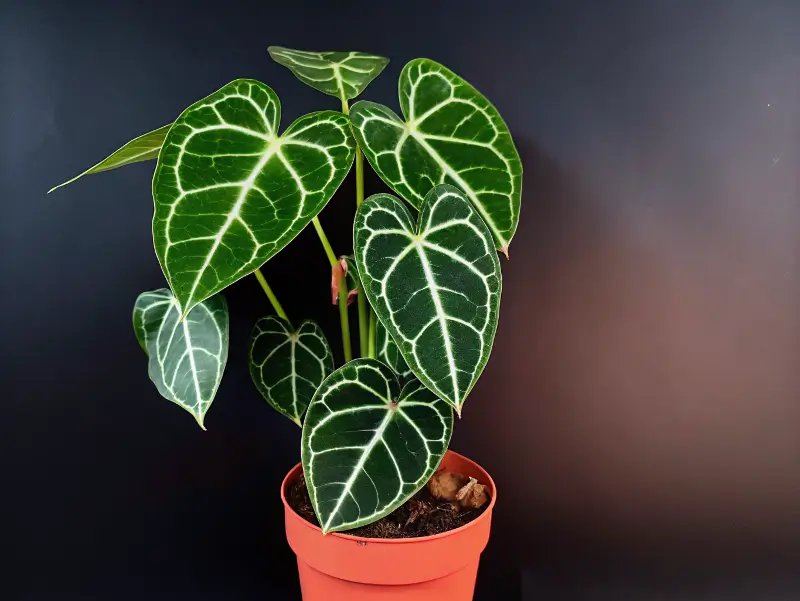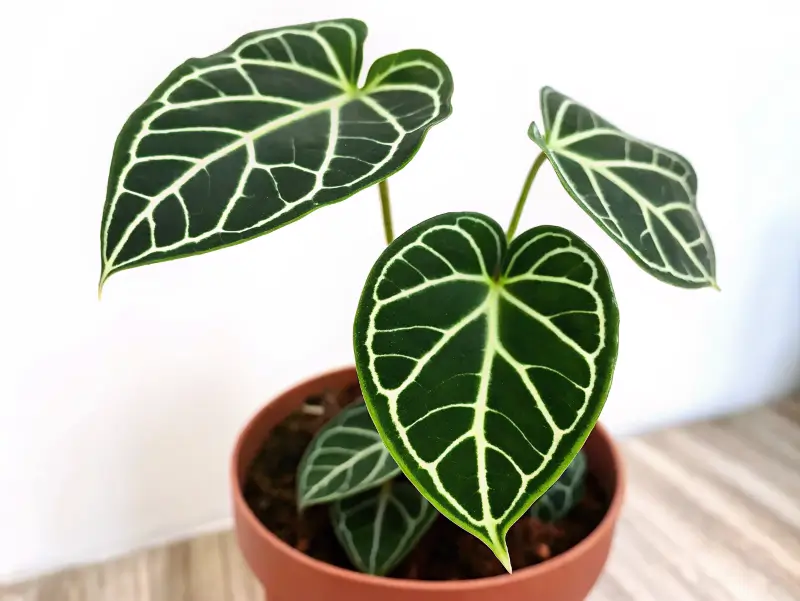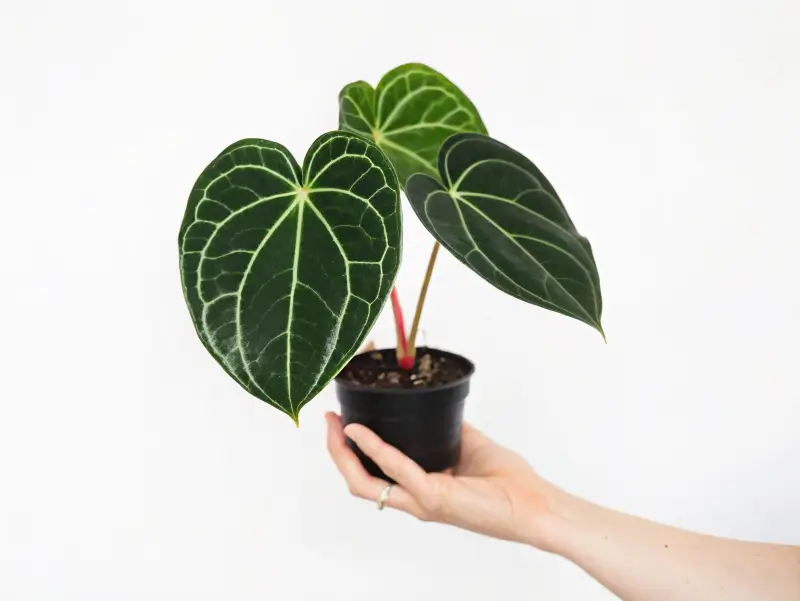
Greetings, fellow plant lover! I’m eager to share my experiences with the anthurium crystallinum that’s making waves among houseplant fans. In this blog post, I’ll dish out friendly, conversational tips on everything from basic anthurium crystallinum care and watering schedules to fast tasks for repotting, troubleshooting common issues, and flaunting those velvety leaves.
I’ll also cover how the crystal anthurium stands out from other species, plus a few insider pointers on pest prevention and leaf health. By the time you finish reading, you’ll feel ready to tackle anthurium crystallinum x magnificum, anthurium crystallinum red, and other aroids like a total pro!
Table of Contents
Understanding Anthurium Crystallinum
Origin and Natural Habitat
I first stumbled upon the anthurium crystallinum when I was browsing exotic foliage houseplants online. People kept raving about its velvety, heart-shaped leaves, and I had to see what the fuss was about. This beauty hails from the lush rainforests of Central and South America, where it grows as an epiphytic rainforest plant. Because it’s part of the aroid family, it’s used to clinging to trees or creeping along damp forest floors.
Honestly, I like to imagine these plants enjoying refreshing rainfall, warm temperatures, and just the right amount of dappled sunlight beneath a thick canopy. In that natural habitat, they appreciate high humidity and free-draining surfaces. Consequently, indoor growers can mimic these conditions with chunky potting mixes and regular misting sessions.
- Quick habitat facts:
- Found in tropical regions of Central and South America
- Grows epiphytically in humid rainforests
- Thrives with filtered light beneath tall trees
Key Botanical Characteristics
The leaves of crystallinum anthurium are heart-shaped, with a velvety finish that glistens when light hits them just right. These leaves often have bold, silvery veins that create an almost sparkly pattern—a total showstopper, if you ask me! When new foliage appears, it can look slightly bronzy or pinkish, which explains why folks get excited over possible anthurium crystallinum red tones.
Furthermore, mature leaves can grow quite large—sometimes bigger than your hand. The plant’s overall structure remains somewhat compact, making it an ideal tropical indoor plant for smaller spaces. Its roots prefer a snug environment, so it doesn’t need a massive pot to shine.
Why Anthurium Crystallinum Is Highly Sought-After
Unique Foliage and Aesthetic Appeal
Many people, myself included, adore anthurium crystal for its striking, velvety leaves. Honestly, the combination of dark green leaf surfaces and shimmering veins gives off an almost regal vibe. Because it looks exotic, crystal anthurium quickly becomes a favorite in any plant collection. I’ve had friends stop by my place, noticing anthurium red crystallinum before they noticed me—no joke!
- Why it’s so popular:
- Mesmerizing leaf patterns with shiny veins
- Velvety leaf texture creates a lush, tropical impression
- Heart-shaped foliage stands out among other houseplants
Comparison with Other Popular Anthurium Species
Although there are plenty of anthuriums on the market, anthurium crystallinum x magnificum is widely sought for its bold leaf shape combined with thick, velvety surfaces. Some anthuriums have flashy flowers, but crystallinum anthurium is more about that showy leaf display. Indeed, the floral spikes are understated compared to the dramatic leaves that steal all the attention.
How to Care for Anthurium Crystallinum

Soil and Potting Mix Requirements
Every time I pot up my anthurium crystallinum care routine, I reach for a chunky aroid potting mix. This usually means combining orchid bark, perlite, and a peat-based mix (or coco coir) to support healthy root development. Because these plants hail from rainforest floors, they want air pockets around their roots and excellent drainage.
- My go-to soil blend:
- 1 part orchid bark
- 1 part peat or coco coir
- 1 part perlite
This combination helps recreate the airy environment of the jungle, minus the actual tree bark your plant might cling to in the wild. Also, sharing this tidbit: I’ve noticed that anthurium crystal enjoys a layer of sphagnum moss on top to keep humidity near the base—especially during drier seasons.
Watering Schedule and Humidity Needs
Watering can be tricky if you’re new to aroids. In my experience, crystallinum anthurium likes consistent moisture, yet it hates being waterlogged. Consequently, I water once the top inch or two of soil feels slightly dry. Then, I water thoroughly and let excess water drain away.
Meanwhile, humidity is the name of the game with a velvety leaf anthurium. Aim for at least 60% humidity, especially if you notice crispy edges forming. I keep a small humidifier running (particularly in winter), and I group moisture-loving houseplants together. A saucer of pebbles and water beneath the pot can also help.
- Humidity tips:
- Maintain 60%+ humidity if possible
- Use a tray of wet pebbles under the pot
- Cluster plants together for a mini microclimate
The Importance of Consistency
Keeping a stable routine is super useful. Indeed, random watering schedules and big temperature swings can stress your anthurium crystallinum x magnificum. I typically water in the morning, giving leaves time to dry before nighttime to avoid fungal issues. Additionally, mild fertilization during the growing season speeds up leaf development, but I never overdo it—maybe once or twice a month at half-strength.
The Light Requirements for Anthurium Crystallinum
Ideal Indoor Lighting Conditions
Because it originates from the rainforest, anthurium crystallinum thrives under bright, indirect light. However, direct sunlight—like harsh noon rays—can scorch those velvet leaves and leave them looking sad. East-facing windows usually work well, though southern windows might need a sheer curtain to diffuse the intensity.
- Lighting sweet spots:
- Bright, indirect sun from east or north windows
- Filtered southern light with curtains or blinds
- Avoid harsh midday rays
If your home has dim corners, you might consider a grow light to give your anthurium crystallinum red enough luminosity to stay vibrant. Keep that light about a foot or two away, and watch for signs of leaf bleaching (indicating you’re overdoing it).
Transitioning from Low Light to Bright, Indirect Sunlight
Sometimes, I rescue a neglected crystal anthurium that’s been sitting in low light. Rather than shock it by plopping it near a blinding window, I move it gradually—maybe a few feet closer each week—until it adjusts. This avoids sudden stress that can cause yellowing or leaf drop. Meanwhile, if leaves remain small or pale, it might need even brighter conditions. To be safe, I always check leaf coloration. If the veins become less distinct, a bit more brightness won’t hurt.
Propagation Techniques for Anthurium Crystallinum

Propagating via Division
To get more anthurium crystallinum care projects going in my home, I turn to division once the plant forms multiple clumps. I gently remove the entire root ball from its pot and divide sections that each have healthy roots and at least one leaf. After that, I repot them into smaller containers using the same chunky mix. Because dividing can be stressful, I do this in spring when new growth is in full swing.
- Steps for division:
- Gently remove plant from pot
- Separate root clusters, ensuring each has roots and a leaf
- Repot in fresh medium, water lightly, and keep warm
Propagating Anthurium Crystallinum from Seeds
Growing from seeds is slower, yet some collectors find it fun. You need high humidity, warm temps, and plenty of patience. Spread seeds on a moist substrate, cover lightly, and keep them in a bright, indirect light area. Over time, seedlings produce those tiny velvet leaves you’ll love. Just don’t expect monster leaves right away—it can take months, sometimes even a year, for them to size up.
Common Pests and Diseases
Recognizing Signs of Infestation
Despite my best efforts, pests do occasionally pop up on my crystal anthurium. Spider mites appear if the air gets too dry. Thrips might cause weird streaks on leaves. Fungus gnats can hover if my soil stays damp for too long. And mealybugs sometimes gather in leaf joints, leaving cottony residue.
- Typical pests to watch for:
- Spider mites (tiny webs and speckles)
- Thrips (silverish streaks)
- Fungus gnats (small flies near moist soil)
- Mealybugs (white, cottony patches)
Preventive Measures and Treatment
If I spot these invaders, I place my anthurium red crystallinum in quarantine—away from other plants—and use insecticidal soap or neem oil. Additionally, consistent watering habits plus proper humidity can keep pests at bay. Proper ventilation, like a small fan, also hinders fungal growth. If leaf spots appear, I remove infected leaves and let the soil dry a bit more before watering again. It’s amazing how quickly a well-timed spray and improved airflow can stop a minor infestation.
Repotting and Transplanting

When and How to Repot Your Anthurium Crystallinum
Generally, I repot my anthurium crystallinum care buddy every two years or so. If roots peek from drainage holes or the potting mix turns dense, that’s my cue to act. I pick a pot just an inch or two bigger in diameter, fill it with fresh airy mix, and gently place the root ball in its new home.
- Repotting tips:
- Check root growth to decide timing
- Go up one pot size at a time
- Avoid heavy soils that trap moisture
(I also recommend checking out Alocasia Frydek if you’re interested in more aroids with stunning leaves.)
Proper Techniques for Handling the Roots
When I unpot, I carefully untangle any circling roots and clip away brown, mushy bits. After that, I re-center the plant and add fresh mix around it. Gentle watering helps everything settle, but I avoid drowning it immediately. Let’s face it, new transplants can be sensitive at first, so slow and steady is the way to go.
Anthurium Crystallinum FAQs
Is Anthurium Crystallinum Hard to Care For?
People often wonder if crystallinum anthurium is fussy. I’d say it’s somewhere in the middle. It craves stable humidity, consistent watering, and bright but indirect light—nothing too extreme though. If you can manage a typical tropical indoor plant routine, you’ll be fine.
- Things to remember:
- Keep humidity around 60%
- Water thoroughly, then allow partial drying
- Provide lots of bright, filtered light
Is Anthurium Crystallinum Rare?
I wouldn’t call anthurium red crystallinum super rare. However, it’s not as common as a basic pothos. Specialty plant shops—and reliable online stores—often stock it. Prices can be slightly higher than common houseplants, but it’s not crazy expensive.
Is Anthurium Crystallinum a Crawler or Climber?
Technically, anthurium crystal can adapt to various growth conditions. It is epiphytic, meaning it may latch onto trees or totems. But it’s not a vigorous climber like some philodendrons. You could give it a moss pole if you want, though it generally stays somewhat compact.
How Much Light Does an Anthurium Crystallinum Need?
Bright, indirect light is key. Direct intense sun might burn those leaves. Meanwhile, medium light can work, but growth will slow. If you see tiny leaves that never develop that signature shine, nudge it closer to a brighter spot or consider a gentle grow light.
Styling and Displaying Anthurium Crystallinum Indoors
I love styling anthurium crystallinum x magnificum in a sleek pot that contrasts with its velvety, dark foliage. White or metallic planters really make those shiny veins pop. Sometimes, I group it with other aroids or tropical indoor plants—like the green-and-yellow Philodendron Brasil—to create a striking mini jungle. Because it’s a moisture-loving houseplant, clustering it with similar plants also bumps up humidity.
- Style suggestions:
- Use pots that match or contrast the leaves
- Cluster with similar tropicals for a rainforest vibe
- Place in a living room corner to catch natural light
Troubleshooting Common Issues
Occasionally, problems crop up, like yellow or droopy leaves. Either you’re watering too often, or you’re ignoring your crystallinum anthurium until it’s bone-dry. Checking soil moisture with your finger is usually enough. Moreover, if leaves keep wilting, consider adding a fan for air circulation. Temperatures below 60°F might also slow growth, causing leaf stress.
For official hints, I sometimes glance at the U.S. Department of Agriculture resources on plant care. While it may not address anthurium crystallinum red specifically, it covers general plant health basics. A bit of detective work often solves most plant woes!
Additional Tips for Anthurium Crystallinum Enthusiasts
For a growth boost, I feed my anthurium red crystallinum a balanced, water-soluble fertilizer at half-strength once every month during spring and summer. Because that’s when it’s actively growing, the roots can use the extra nutrients. I keep the fertilizing low-key in fall and winter, giving the plant a break.
- Fertilizer tips:
- Apply half-strength formula monthly in warmer months
- Reduce feeding in cooler seasons
- Monitor leaf color for overfeeding or nutrient deficiency
Keep room temperatures around 65–80°F. If you maintain warm, humid air and adequate light, your crystal anthurium can reward you with fresh, velvety leaves year-round!

1 thought on “Anthurium Crystallinum: Ultimate Growing and Caring Guide”
Comments are closed.